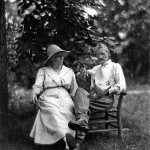Having marked Nashville’s centennial as “The Art Colony of the Midwest” in 2007, it’s easy to forget that the Brown County village was not always the epicenter of the visual arts in Indiana. A significant regional school of painting developed in the Wayne County town of Richmond in the late nineteenth century, of which the Richmond Palette Club and the Richmond Prize were manifestations. Other artistic hubs existed in Muncie and Indianapolis during the Hoosier school’s heyday. Even T.C. Steele, the acknowledged dean of the movement, who is forever associated with Brown County, made his home there only in his golden years.
Steele had purchased a retreat in 1898 with colleague J. Ottis Adams in the Franklin County town of Brookville, a picturesque spot on the West Fork of the Whitewater River. The opening of a railway station in the Brown County town of Helmsburg increased traffic to Brown County in the first years of the 20 th century, and artists soon discovered the hamlet of Nashville, where they would stay in the Pittman Inn during the summer and early fall.
Steele and his second wife Selma built their hilltop residence, The House of the Singing Winds, in nearby Belmont in 1907; and the area fondly known as “Peaceful Valley” began attracting a second generation of impressionistic Hoosier painters, including Adolph Schulz, Louis Oscar Griffith, Marie Goth and Glen Cooper Henshaw. Formed in 1926 with painter Carl Graf at the helm, The Brown County Art Gallery Association has represented the professional artists who have gathered around Nashville ever since.






















